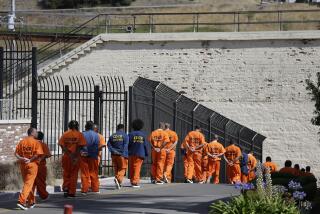Opinion: California’s anti-lynch law -- the word is there for a reason
You have to wonder what upset Maile Mae Hampton more: being arrested during a Black Lives Matter protest in Sacramento in January or the charge she faced -- lynching.
This week, Sacramento prosecutors dropped the felony lynching charge against the young activist, leaving a misdemeanor charge of interfering with a peace officer, which does not, said chief deputy Dist. Atty. Steve Grippi, “carry with it the racially charged and inflammatory terminology” of lynching.
Most people use the word differently, but in the law -- in this instance California penal code 405a -- lynching is “the taking by means of a riot of any person from the lawful custody of a peace officer,” not a mob killing someone by hanging. Hampton was accused of trying to pull a fellow protester away from police.
The paradox is that in the 1930s, an enlightened California passed a progressive anti-lynching law -- evidently the same one Hampton was arrested under -- at a moment in history when the U.S. Congress was refusing to do so.
Vigilante murders of African Americans were on the rise through the 1920s and ‘30s and into the ‘50s, and a federal anti-lynch law would have allowed U.S. attorneys to prosecute mob violence even though the states almost never did. But decades of filibusters and threats of filibusters by Southern senators doomed that federal law. One such bill, introduced in 1937 by the first black Democratic congressman in history, was snubbed by his colleagues.
Over the course of some 75 years, about 4,000 black men, women and children were killed by vigilante lynch mobs in a dozen Southern states. And it wasn’t just the South; a turn-of-the-century Kansas man was burned alive, a Nebraska man shot “1,000 times.”
The gruesome practice, which The Times denounced in 1899 as “lynching saturnalias,” made it into films. Tom Robinson, the black man unjustly accused in “To Kill a Mockingbird,” was the target of a lynch mob at the town jail. In the 1936 movie “Fury,” a lynch mob shows up to snatch accused child kidnaper Spencer Tracy from his jail cell. “The Ox-Bow Incident” tells the story of frontier vigilantes who killed three men they wrongly believed were cattle rustlers.
“Vigilance committees” killed Mexicans in the early years of California statehood. In the nation’s largest single deadly lynching, in 1891, 11 Italian immigrants, some of whom had just been acquitted on charges of murdering the New Orleans police chief, were taken from custody by furious locals and hanged from lampposts or shot.
What happened to Maile Mae Hampton bothered California state Sen. Holly Mitchell (D-Culver City) enough that she’s written a bill to cut out the word “lynch” from the California Penal Code.
She’s right when she says, according to Capitol Public Radio, that “African Americans tend to have a real visceral response to the term itself.”
But she’s wrong to try to expunge the word from the law. We need strong words for strong concepts. The fact that a “lynch” law was invoked against one young black woman isn’t reason enough to purge the term from the legal books.
For one thing, we shouldn’t legislate by the outlier, the exception, the aberration.
For another, and more compellingly, the lynch law took too long -- decades too long, after the hard work of too many passionate advocates like Ida B. Wells, and the torture and killing of too many men and women -- to make it into law at all.
And there it should stay. If ever we need to invoke it again against vigilantes and mobs, the word will still be there, powerful, imbued with all the righteous wrath and blameless blood that it took to get it on the books in the first place.
Follow Patt Morrison on Twitter @pattmlatimes
More to Read
A cure for the common opinion
Get thought-provoking perspectives with our weekly newsletter.
You may occasionally receive promotional content from the Los Angeles Times.







